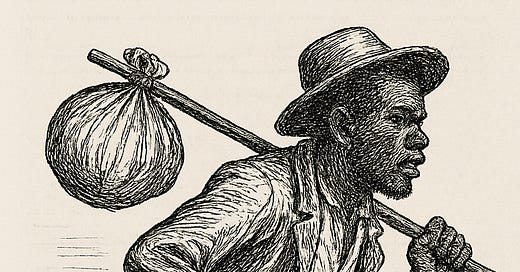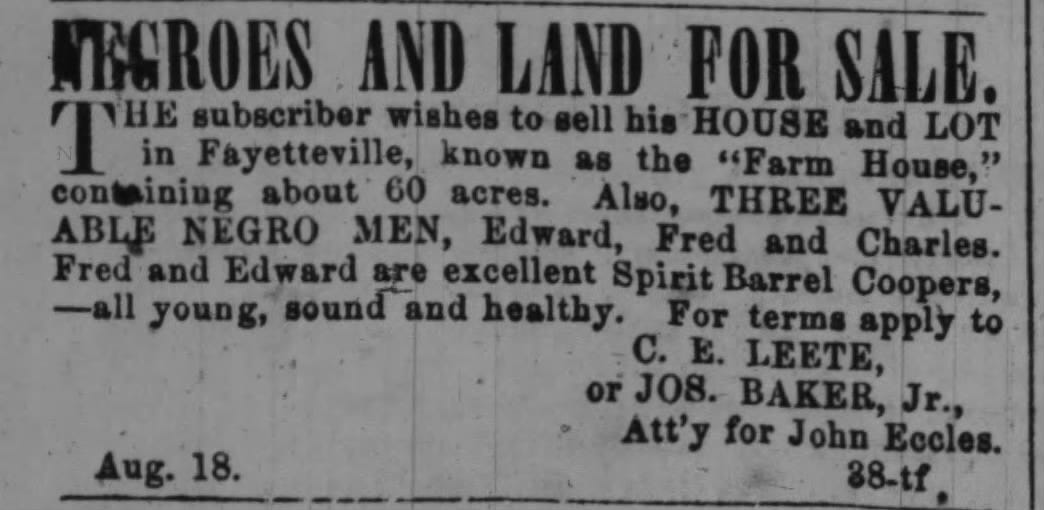The Enslaved of Fayetteville: Tracing Enslavement in Cumberland County, North Carolina
Uncovering the Lives of the Enslaved Through Newspaper Records and Historical Research
Introduction
Before the end of enslavement in 1865, Fayetteville, North Carolina, like many Southern cities, had a significant enslaved population. The evidence of this history is found in historical records, including newspapers, wills, and census data. One particularly valuable resource is the Fayetteville Weekly Observer, which published advertisements that provide firsthand accounts of how enslaved individuals were bought, sold, and sought freedom. These records reveal not only the brutality of enslavement but also the resilience of those who lived through it.
Enslavement in Fayetteville: Evidence from Newspaper Advertisements
Newspaper advertisements offer a stark glimpse into the daily reality of enslavement in Fayetteville. Enslaved individuals were treated as property, bought and sold alongside land and livestock. At the same time, some ads reveal the names and skills of enslaved people, details that can be invaluable for genealogical research.
The Sale of Enslaved Individuals
One striking advertisement published in the Fayetteville Weekly Observer in August 1851 reads:
“WANTED TO BUY, 25 OR 30 LIKELY YOUNG NEGROES: apply at the Fayetteville Hotel.”
This chilling ad demonstrates how Fayetteville was a hub for the buying and selling of enslaved people. The term "likely young negroes" suggests that traders were particularly interested in young, able-bodied individuals, likely for labor-intensive work.
Another advertisement from the same newspaper lists enslaved individuals for sale alongside land:
“NEGROES AND LAND FOR SALE. The subscriber wishes to sell his HOUSE and LOT in Fayetteville, known as the ‘Farm House,’ containing about 60 acres. Also, THREE VALUABLE NEGRO MEN, Edward, Fred, and Charles. Fred and Edward are excellent Spirit Barrel Coopers—all young, sound and healthy.”
This ad emphasizes the economic value placed on skilled enslaved workers. Spirit barrel coopers were essential to industries like shipping and alcohol production, and the mention of their expertise highlights how enslaved labor contributed to Fayetteville’s economy.
Runaway Ads and Resistance
Enslaved individuals resisted their bondage in many ways, and some sought freedom through escape. Their attempts were met with fierce retaliation, and newspaper ads often served as tools for enslavers to reclaim them.
A July 1851 ad details the escape of two men:
“$20 REWARD (for each). RANAWAY in December, 1850, my negro boys ABRAM and HENRY. Henry is 5 feet 7 inches high, and about 35 years old. He is well known in Fayetteville, where he learned the Blacksmith trade. He is rather small, and very dark, with a downcast look. Abram is 5 feet 10 inches high, about 25 years old, something lighter of complexion than Henry, stout and well-formed, and walks upright. These negroes are thought to be in Robeson County, near the ‘Big Swamp.’”
This ad reveals important details: Henry was a blacksmith, a highly skilled profession, and was well known in Fayetteville. The mention of Robeson County and “Big Swamp” hints at a possible network of support for runaways in the area, where free Black people and Native American communities lived. Listen to How Have You Come to Know about the Maroons?
Enslaved Labor and Fayetteville’s Economy
The advertisements also demonstrate how Fayetteville’s economy relied heavily on enslaved labor. Skilled enslaved workers, such as blacksmiths, coopers, and craftsmen, played a crucial role in the city’s industries. Their skills were not just useful but highly valuable, as seen in the descriptions in sale ads.
Connecting the Past to the Present
Understanding Fayetteville’s history of enslavement is not just an academic exercise—it is essential for families today who are tracing their ancestry. Many African Americans seeking to learn more about their roots may find crucial clues in these historical records. By piecing together names, locations, and occupations, descendants of enslaved people can uncover their ancestors’ lives and stories.
For those researching enslaved ancestors, local archives, newspaper collections, and probate records are invaluable resources. Looking beyond digital indexes and into historical newspapers, wills, and estate documents can help reconstruct family histories that were nearly erased.
Conclusion
The history of enslaved individuals in Fayetteville is deeply woven into the city’s past. The newspaper ads from the Fayetteville Weekly Observer paint a vivid and often painful picture of that reality. However, they also offer valuable insights that help us remember the names, skills, and struggles of those who lived through this era.
By examining these records, we not only acknowledge the injustices of the past but also give voice to those who were once silenced. If you are researching your ancestry or interested in local history, consider diving into historical archives—you never know what stories you might uncover.
Extra Measure
Have you come across records that mention enslaved individuals in Fayetteville or elsewhere? Have you found names or details that connect to your family’s history? Check out my other blog post: We Were Here: Enslaved in Cumberland County, North Carolina. The NC History Center on the Civil War, Emancipation & Reconstruction has stories about enslavement from 1838-1865. Share your discoveries and insights in our chat or the comments below!










To understand slavery it's important to have working knowledge of The Compromise of 1850, read Time on the Cross by Fogel & Engerman, and to understand the 1850 slave census. Illinois is particularly interesting due to the fact that slavery existed in a so called "Free State." The most profound discovery is that slavery was quite varied in specific form depending on the location, local industry and demographic structure. It was often at variance with the Hollywood plantation version that is commonly accepted. Newspaper and probate records tend to diminish the agency of the enslaved.